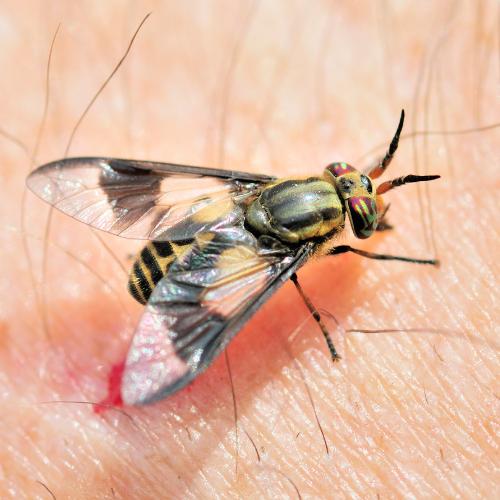Deer Fly

Proud Supporter of Disabled Veterans
No Contracts
Services provided without written contracts.
Introduction to
Deer flies, belonging to the genus Chrysops, are notorious for their painful bites and their ability to spread diseases among humans and animals. These robust, fast-flying insects are often encountered in rural and wooded areas, particularly near bodies of water. Understanding the biology, habits, and effective prevention methods for deer flies is crucial for minimizing their impact on outdoor activities and protecting both human and animal health. Managing their presence can significantly enhance the enjoyment and safety of spending time in nature.
Recognition
Deer flies are medium-sized flies, typically measuring 6 to 12 mm in length. They have distinctive banded wings, bright eyes often marked with iridescent patterns, and stout bodies that are yellow, black, or a combination of both. Their antennae are short, and their mouthparts are adapted for biting and blood-feeding. Unlike horse flies, deer flies are smaller and have more prominent eye patterns. They can be distinguished from other biting flies by their unique wing markings and the painful bites they deliver. Their presence is often indicated by their persistent circling around the head and shoulders of their hosts.
Biology
Deer flies undergo complete metamorphosis, with four distinct life stages: egg, larva, pupa, and adult. Females lay eggs in clusters on vegetation near water bodies. The eggs hatch into larvae, which drop into the water or moist soil where they feed on organic matter and small invertebrates. After several molts, the larvae pupate in the soil or sediment. Adult flies emerge from pupae, with females seeking blood meals necessary for egg development, while males primarily feed on nectar and plant juices. Deer flies are known for their aggressive biting behavior and their ability to transmit diseases such as tularemia.
Habits
Deer flies are typically found in rural and wooded areas, particularly near lakes, streams, and marshes where they breed. They prefer moist, shaded environments and are most active during warm, sunny days. Deer flies are visual hunters, attracted to movement and dark colors. They feed on the blood of mammals, including humans, livestock, and wildlife. Their bites are painful and can cause allergic reactions in some individuals. Unlike mosquitoes, deer flies are day biters and are most active during the middle of the day. They are often found in swarms and can be highly persistent in their attempts to bite.
Prevention
Preventing deer fly bites involves a combination of personal protection and environmental management. Wear light-colored clothing to reduce attractiveness and cover exposed skin with long sleeves and pants. Use insect repellents containing DEET, picaridin, or permethrin on skin and clothing. Avoid areas with heavy deer fly activity during peak biting times. Reducing breeding sites by managing standing water and clearing vegetation around water bodies can help decrease local deer fly populations. Using physical barriers such as head nets and fine mesh screens can also provide protection during outdoor activities.
Professional
If deer flies become a persistent problem, professional pest control services can provide effective solutions. STL Pest Control offers targeted treatments to reduce deer fly populations around homes and recreational areas. Their technicians are trained to identify breeding sites and implement control measures tailored to the specific environment. In severe cases, they may recommend ongoing maintenance plans to keep deer fly populations at manageable levels. Professional services ensure thorough and long-lasting control, reducing the risk of bites and enhancing outdoor comfort and safety.



Our Office







